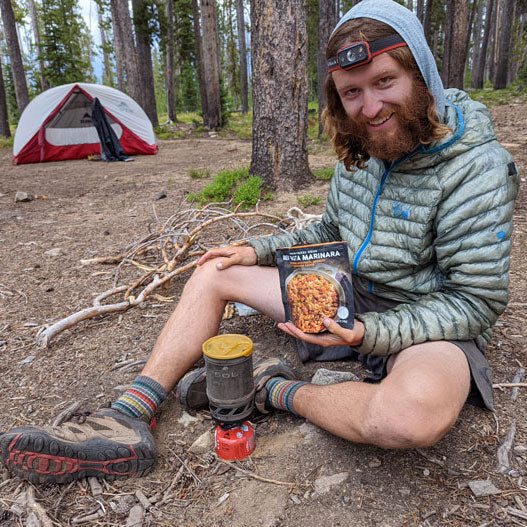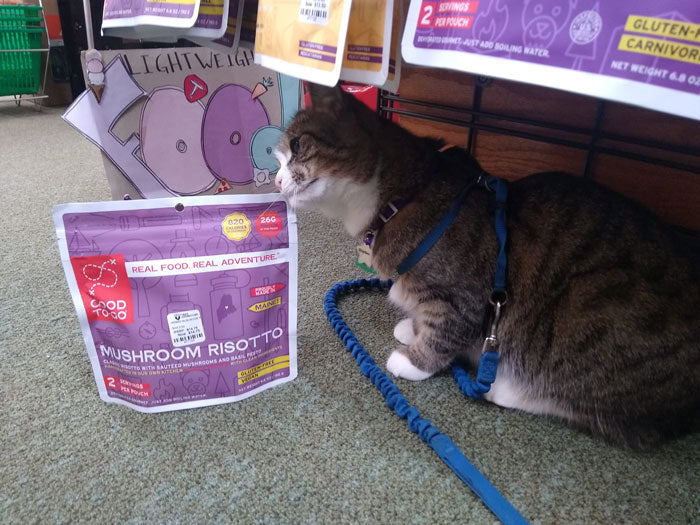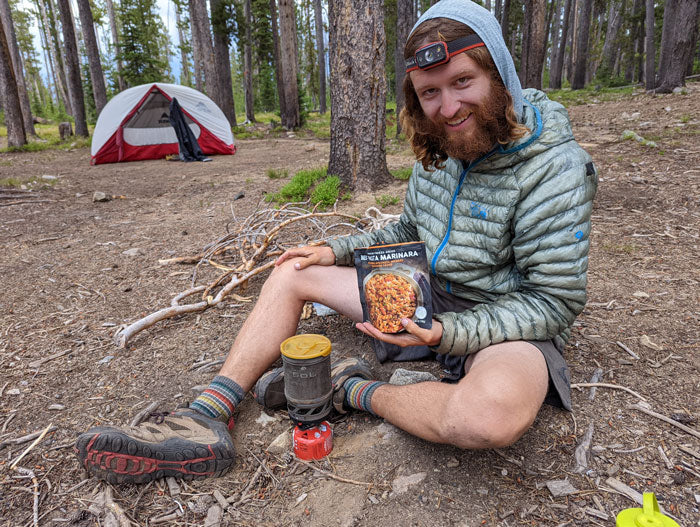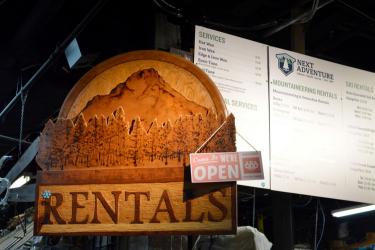
Backpacking Food Ideas
Whether you’re setting out on a short hike, a day on the ski slopes, or a multi-day backpacking trip, finding the proper food can be a challenge. When we’re active in the outdoors our bodies require additional sustenance. Without the conveniences of a modern kitchen, it can be difficult to prepare foods that are both appealing and nutritious. In this article, I will discuss the most important factors to consider when choosing snacks and meals for the outdoors, and introduce you to some of my favorite outdoor foods carried at Next Adventure. I’ll discuss the necessary equipment for preparing food in the backcountry, and conclude with some of my personal tips for cooking and eating in the outdoors.
 First consideration: Warmth
One of the first things I think about when setting off into the backcountry is whether or not I want to bring my stove. While it is always important to have a heat source (at the very least, a way to start a fire), many campers and backcountry travelers may choose not to bring a device for cooking. There are many foods that can be eaten without cooking—snack bars and trail mixes for example. There is even a process called cold soaking which allows you to prepare a water-based meal without a stove.
When choosing whether or not to bring a stove on a backcountry trip, I like to think about the warmth factor. After a long day of hiking, or at the beginning of a cold evening, having a warm meal to prepare can be a comfort or even a lifesaver. This alone often makes a portable camping stove worth the weight. If you do choose to bring a stove into the backcountry, think about what you might want to cook and how you will be transporting your cooking setup. When driving into a campground I’ll usually bring a two-burner propane stove, which functions similarly to a kitchen stovetop. Two burner stoves allow for variation in heat output and can be used to cook anything from vegetables for dinner to pancakes and bacon in the morning.
Usually, two burner stoves will be too bulky and heavy for transport into the backcountry. When this is the case, a single-burner isobutane (Such as the Jetboil MightyMo) or liquid fuel stove can be used to prepare food instead. Single burner stoves are great for boiling water, but when deciding on meals you should keep in mind their limitations. These stoves burn hot. While isobutane stoves with regulators and liquid fuel stoves allow for some temperature adjustment, it is difficult to do much more than boil water for dehydrated meals, pasta, and rice with a single burner stove. Read on for some meal suggestions to prepare on a single-burner stove.
First consideration: Warmth
One of the first things I think about when setting off into the backcountry is whether or not I want to bring my stove. While it is always important to have a heat source (at the very least, a way to start a fire), many campers and backcountry travelers may choose not to bring a device for cooking. There are many foods that can be eaten without cooking—snack bars and trail mixes for example. There is even a process called cold soaking which allows you to prepare a water-based meal without a stove.
When choosing whether or not to bring a stove on a backcountry trip, I like to think about the warmth factor. After a long day of hiking, or at the beginning of a cold evening, having a warm meal to prepare can be a comfort or even a lifesaver. This alone often makes a portable camping stove worth the weight. If you do choose to bring a stove into the backcountry, think about what you might want to cook and how you will be transporting your cooking setup. When driving into a campground I’ll usually bring a two-burner propane stove, which functions similarly to a kitchen stovetop. Two burner stoves allow for variation in heat output and can be used to cook anything from vegetables for dinner to pancakes and bacon in the morning.
Usually, two burner stoves will be too bulky and heavy for transport into the backcountry. When this is the case, a single-burner isobutane (Such as the Jetboil MightyMo) or liquid fuel stove can be used to prepare food instead. Single burner stoves are great for boiling water, but when deciding on meals you should keep in mind their limitations. These stoves burn hot. While isobutane stoves with regulators and liquid fuel stoves allow for some temperature adjustment, it is difficult to do much more than boil water for dehydrated meals, pasta, and rice with a single burner stove. Read on for some meal suggestions to prepare on a single-burner stove.
 It’s really nice having a hot meal at the end of a day of hiking
Second Consideration: Hydration
While caloric intake is important in the backcountry, hydration can be even more crucial. Water is (obviously) an important source of hydration, but water-based meals such as soups can also be a good source of hydration. It is also important to consume salt and electrolytes along with water, to replace sweat when exercising in the backcountry. One of the best ways to do this is with water additives such as nuun tablets.
Third Consideration: Nutrition
When choosing food for the backcountry, it is important to select meals and snacks that will help your body maintain enough energy to function at peak performance. The most basic way is to keep track of Calories. In browsing outdoor snacks and meals, you will notice many of these foods are dense in Caloric content—that is, they contain many Calories packed into a small and lightweight container, perfect for transporting in a backpack. Remember that Calories consumed translates directly to energy burned. Consuming 2,000 Calories per day is recommended for the average person. After a day of strenuous outdoor activity, it is likely that your body will require more than 2,000 Calories; therefore you will be hungrier and need to consume more food than you normally would at home.
Sugar is also an important component of backcountry food. Though it is necessary to maintain a well-balanced diet (I.e. you need more than just candy bars in the backcountry), it is also important to maintain a healthy blood sugar level. Sugar alone isn’t enough to sustain someone in the backcountry, but it is a quick source of energy. Many backcountry snacks are high in sugar content and contain ingredients such as honey and maple syrup.
Sodium is an important ingredient in many backcountry snacks and meals. After a day of strenuous activity, sodium-rich food is a great way to replenish salt lost through sweating.
And finally, you’ll notice that many backcountry foods contain high quantities of protein. Protein is essential for rebuilding muscles after a day on the trails.
It’s really nice having a hot meal at the end of a day of hiking
Second Consideration: Hydration
While caloric intake is important in the backcountry, hydration can be even more crucial. Water is (obviously) an important source of hydration, but water-based meals such as soups can also be a good source of hydration. It is also important to consume salt and electrolytes along with water, to replace sweat when exercising in the backcountry. One of the best ways to do this is with water additives such as nuun tablets.
Third Consideration: Nutrition
When choosing food for the backcountry, it is important to select meals and snacks that will help your body maintain enough energy to function at peak performance. The most basic way is to keep track of Calories. In browsing outdoor snacks and meals, you will notice many of these foods are dense in Caloric content—that is, they contain many Calories packed into a small and lightweight container, perfect for transporting in a backpack. Remember that Calories consumed translates directly to energy burned. Consuming 2,000 Calories per day is recommended for the average person. After a day of strenuous outdoor activity, it is likely that your body will require more than 2,000 Calories; therefore you will be hungrier and need to consume more food than you normally would at home.
Sugar is also an important component of backcountry food. Though it is necessary to maintain a well-balanced diet (I.e. you need more than just candy bars in the backcountry), it is also important to maintain a healthy blood sugar level. Sugar alone isn’t enough to sustain someone in the backcountry, but it is a quick source of energy. Many backcountry snacks are high in sugar content and contain ingredients such as honey and maple syrup.
Sodium is an important ingredient in many backcountry snacks and meals. After a day of strenuous activity, sodium-rich food is a great way to replenish salt lost through sweating.
And finally, you’ll notice that many backcountry foods contain high quantities of protein. Protein is essential for rebuilding muscles after a day on the trails.
 Nutrition facts for a Range meal bar: as you can see, this lightweight (5.7 oz) bar is packed with 700 Calories, 19g of protein, 400mg of sodium, 45g of sugar, and a bunch of other nutrients.
The Good Stuff: Backcountry Food Recommendations
Snacks are important to pack for any outdoor activity. When planning for a hike, I usually pack a combination of salty trail mix (nuts are a good source of protein), dried fruits, and snack bars. Next Adventure carries a few different snack bars I enjoy, including Clif Bars (a backcountry staple) and the locally made Better Bar. On longer hikes or on backpacking trip where I don’t plan to stop for lunch I sometimes carry Range Meal Bars, which contain 700 Calories and are basically a meal on their own.
Nutrition facts for a Range meal bar: as you can see, this lightweight (5.7 oz) bar is packed with 700 Calories, 19g of protein, 400mg of sodium, 45g of sugar, and a bunch of other nutrients.
The Good Stuff: Backcountry Food Recommendations
Snacks are important to pack for any outdoor activity. When planning for a hike, I usually pack a combination of salty trail mix (nuts are a good source of protein), dried fruits, and snack bars. Next Adventure carries a few different snack bars I enjoy, including Clif Bars (a backcountry staple) and the locally made Better Bar. On longer hikes or on backpacking trip where I don’t plan to stop for lunch I sometimes carry Range Meal Bars, which contain 700 Calories and are basically a meal on their own.
 Meals
Though minimal cooking is possible in the backcountry if you want to make your own camping meals, it is often easier to prepare a freeze dried or dehydrated meal. Both of these options are prepackaged dried foods—usually elaborate meals, where you simply add boiling water and wait for the food to rehydrate. Here are some of my favorites:
• Alpineaire: Alpineaire makes a wide variety of relatively inexpensive comfort foods, which are easy to rehydrate. They are freeze dried and have an incredibly long shelf life (30 years), so are great to have on hand for emergencies. Try the Forever Young Mac and Cheese, or the Chocolate Mudslide Dessert!
• Backpacker’s Pantry: Backpackers Pantry meals are also freeze dried and have an incredibly long shelf life. I like Backpacker’s Pantry because their meals are dried using 100% solar energy captured onsite at their factory in Boulder, CO. Try the Fettuccini Alfredo with Chicken!
• Good 2 Go: Good 2 Go meals are made in Maine from local, sustainably sourced ingredients. Good 2 Go meals are dehydrated (not freeze dried) so, while they have a shorter (5 year) shelf life, they taste fresher. Good 2 Go also makes some great vegan and vegetarian meals: try the Herbed Mushroom Risotto, my all-time favorite backpacking meal!
• Fernweh: Fernweh foods are locally made here in Portland, Oregon and are sealed inside of a compostable ziplock bag. Their meals are entirely vegan and are sustainably produced; try the Mushroom Pot Pie!
Meals
Though minimal cooking is possible in the backcountry if you want to make your own camping meals, it is often easier to prepare a freeze dried or dehydrated meal. Both of these options are prepackaged dried foods—usually elaborate meals, where you simply add boiling water and wait for the food to rehydrate. Here are some of my favorites:
• Alpineaire: Alpineaire makes a wide variety of relatively inexpensive comfort foods, which are easy to rehydrate. They are freeze dried and have an incredibly long shelf life (30 years), so are great to have on hand for emergencies. Try the Forever Young Mac and Cheese, or the Chocolate Mudslide Dessert!
• Backpacker’s Pantry: Backpackers Pantry meals are also freeze dried and have an incredibly long shelf life. I like Backpacker’s Pantry because their meals are dried using 100% solar energy captured onsite at their factory in Boulder, CO. Try the Fettuccini Alfredo with Chicken!
• Good 2 Go: Good 2 Go meals are made in Maine from local, sustainably sourced ingredients. Good 2 Go meals are dehydrated (not freeze dried) so, while they have a shorter (5 year) shelf life, they taste fresher. Good 2 Go also makes some great vegan and vegetarian meals: try the Herbed Mushroom Risotto, my all-time favorite backpacking meal!
• Fernweh: Fernweh foods are locally made here in Portland, Oregon and are sealed inside of a compostable ziplock bag. Their meals are entirely vegan and are sustainably produced; try the Mushroom Pot Pie!
 Rehydrated Good 2 Go Pad Thai
Dehydrating Your Own Food
If you spend a lot of time outdoors, you may want to consider dehydrating your own food. Though intimidating, dehydrating your own snacks and meals is simple if you purchase a dehydrator (we don’t sell them at Next Adventure, but you can purchase a basic dehydrator from Amazon for as little as $50). The dehydrator will remove any moisture from pre-prepared meals, leaving behind dried food which will remain fresh for a few months if stored in an airtight container in the freezer. I have had good luck dehydrating pasta-based meals, chilis, fruit, vegetables, and potatoes. A quick search for recipes will reveal that the opportunities are endless!
Rehydrated Good 2 Go Pad Thai
Dehydrating Your Own Food
If you spend a lot of time outdoors, you may want to consider dehydrating your own food. Though intimidating, dehydrating your own snacks and meals is simple if you purchase a dehydrator (we don’t sell them at Next Adventure, but you can purchase a basic dehydrator from Amazon for as little as $50). The dehydrator will remove any moisture from pre-prepared meals, leaving behind dried food which will remain fresh for a few months if stored in an airtight container in the freezer. I have had good luck dehydrating pasta-based meals, chilis, fruit, vegetables, and potatoes. A quick search for recipes will reveal that the opportunities are endless!

 Home dehydrated potatoes (left) and peppers, broccoli, and mushrooms (right).
Conclusion: Eat What You Enjoy
Choosing food with the proper nutrients for your next backcountry trip is important. It is equally important to think about foods that are realistic to carry on your outing. Dehydrated foods and snack bars are great because they contain high amounts of Calories and Protein but still come in light-weight, compact packages.
However, at the end of the day, you have to carry what you enjoy eating. I do a lot of long-distance backpacking. When I go into town to resupply, in addition to snack bars and dehydrated meals I usually buy a lot of my favorite foods. Chips and candy are great trail foods, and something that I know I’ll always want to eat; pop tarts are a great sugary breakfast to eat quickly when first waking up. Meat and cheese might be relatively heavy, but I often crave these foods at the end of a long day. I’ve even carried cans of frosting into the backcountry for quick energy. Often when exploring the backcountry, you’re burning more calories and your body can process foods it wouldn’t normally be able to at home, giving you the freedom to enjoy the snacks that you want.
Home dehydrated potatoes (left) and peppers, broccoli, and mushrooms (right).
Conclusion: Eat What You Enjoy
Choosing food with the proper nutrients for your next backcountry trip is important. It is equally important to think about foods that are realistic to carry on your outing. Dehydrated foods and snack bars are great because they contain high amounts of Calories and Protein but still come in light-weight, compact packages.
However, at the end of the day, you have to carry what you enjoy eating. I do a lot of long-distance backpacking. When I go into town to resupply, in addition to snack bars and dehydrated meals I usually buy a lot of my favorite foods. Chips and candy are great trail foods, and something that I know I’ll always want to eat; pop tarts are a great sugary breakfast to eat quickly when first waking up. Meat and cheese might be relatively heavy, but I often crave these foods at the end of a long day. I’ve even carried cans of frosting into the backcountry for quick energy. Often when exploring the backcountry, you’re burning more calories and your body can process foods it wouldn’t normally be able to at home, giving you the freedom to enjoy the snacks that you want.

 Part of a resupply from a long-distance backpacking trip (left). Bean dip and Flamin’ Hot Cheetos on a wrap, one of my favorite untraditional backcountry meals (right)
My final advice? Start with the ideal backcountry basics: snack bars and dehydrated meals, and the Calorie and protein rich foods mentioned in this article. But be sure to bring a few guilty pleasures, too—things you know you’ll eat, things to reward yourself at the top of the next mountain. After all, trips into the backcountry are meant to be enjoyed.
Part of a resupply from a long-distance backpacking trip (left). Bean dip and Flamin’ Hot Cheetos on a wrap, one of my favorite untraditional backcountry meals (right)
My final advice? Start with the ideal backcountry basics: snack bars and dehydrated meals, and the Calorie and protein rich foods mentioned in this article. But be sure to bring a few guilty pleasures, too—things you know you’ll eat, things to reward yourself at the top of the next mountain. After all, trips into the backcountry are meant to be enjoyed.
 First consideration: Warmth
One of the first things I think about when setting off into the backcountry is whether or not I want to bring my stove. While it is always important to have a heat source (at the very least, a way to start a fire), many campers and backcountry travelers may choose not to bring a device for cooking. There are many foods that can be eaten without cooking—snack bars and trail mixes for example. There is even a process called cold soaking which allows you to prepare a water-based meal without a stove.
When choosing whether or not to bring a stove on a backcountry trip, I like to think about the warmth factor. After a long day of hiking, or at the beginning of a cold evening, having a warm meal to prepare can be a comfort or even a lifesaver. This alone often makes a portable camping stove worth the weight. If you do choose to bring a stove into the backcountry, think about what you might want to cook and how you will be transporting your cooking setup. When driving into a campground I’ll usually bring a two-burner propane stove, which functions similarly to a kitchen stovetop. Two burner stoves allow for variation in heat output and can be used to cook anything from vegetables for dinner to pancakes and bacon in the morning.
Usually, two burner stoves will be too bulky and heavy for transport into the backcountry. When this is the case, a single-burner isobutane (Such as the Jetboil MightyMo) or liquid fuel stove can be used to prepare food instead. Single burner stoves are great for boiling water, but when deciding on meals you should keep in mind their limitations. These stoves burn hot. While isobutane stoves with regulators and liquid fuel stoves allow for some temperature adjustment, it is difficult to do much more than boil water for dehydrated meals, pasta, and rice with a single burner stove. Read on for some meal suggestions to prepare on a single-burner stove.
First consideration: Warmth
One of the first things I think about when setting off into the backcountry is whether or not I want to bring my stove. While it is always important to have a heat source (at the very least, a way to start a fire), many campers and backcountry travelers may choose not to bring a device for cooking. There are many foods that can be eaten without cooking—snack bars and trail mixes for example. There is even a process called cold soaking which allows you to prepare a water-based meal without a stove.
When choosing whether or not to bring a stove on a backcountry trip, I like to think about the warmth factor. After a long day of hiking, or at the beginning of a cold evening, having a warm meal to prepare can be a comfort or even a lifesaver. This alone often makes a portable camping stove worth the weight. If you do choose to bring a stove into the backcountry, think about what you might want to cook and how you will be transporting your cooking setup. When driving into a campground I’ll usually bring a two-burner propane stove, which functions similarly to a kitchen stovetop. Two burner stoves allow for variation in heat output and can be used to cook anything from vegetables for dinner to pancakes and bacon in the morning.
Usually, two burner stoves will be too bulky and heavy for transport into the backcountry. When this is the case, a single-burner isobutane (Such as the Jetboil MightyMo) or liquid fuel stove can be used to prepare food instead. Single burner stoves are great for boiling water, but when deciding on meals you should keep in mind their limitations. These stoves burn hot. While isobutane stoves with regulators and liquid fuel stoves allow for some temperature adjustment, it is difficult to do much more than boil water for dehydrated meals, pasta, and rice with a single burner stove. Read on for some meal suggestions to prepare on a single-burner stove.
 It’s really nice having a hot meal at the end of a day of hiking
It’s really nice having a hot meal at the end of a day of hiking Nutrition facts for a Range meal bar: as you can see, this lightweight (5.7 oz) bar is packed with 700 Calories, 19g of protein, 400mg of sodium, 45g of sugar, and a bunch of other nutrients.
Nutrition facts for a Range meal bar: as you can see, this lightweight (5.7 oz) bar is packed with 700 Calories, 19g of protein, 400mg of sodium, 45g of sugar, and a bunch of other nutrients. Meals
Though minimal cooking is possible in the backcountry if you want to make your own camping meals, it is often easier to prepare a freeze dried or dehydrated meal. Both of these options are prepackaged dried foods—usually elaborate meals, where you simply add boiling water and wait for the food to rehydrate. Here are some of my favorites:
• Alpineaire: Alpineaire makes a wide variety of relatively inexpensive comfort foods, which are easy to rehydrate. They are freeze dried and have an incredibly long shelf life (30 years), so are great to have on hand for emergencies. Try the Forever Young Mac and Cheese, or the Chocolate Mudslide Dessert!
• Backpacker’s Pantry: Backpackers Pantry meals are also freeze dried and have an incredibly long shelf life. I like Backpacker’s Pantry because their meals are dried using 100% solar energy captured onsite at their factory in Boulder, CO. Try the Fettuccini Alfredo with Chicken!
• Good 2 Go: Good 2 Go meals are made in Maine from local, sustainably sourced ingredients. Good 2 Go meals are dehydrated (not freeze dried) so, while they have a shorter (5 year) shelf life, they taste fresher. Good 2 Go also makes some great vegan and vegetarian meals: try the Herbed Mushroom Risotto, my all-time favorite backpacking meal!
• Fernweh: Fernweh foods are locally made here in Portland, Oregon and are sealed inside of a compostable ziplock bag. Their meals are entirely vegan and are sustainably produced; try the Mushroom Pot Pie!
Meals
Though minimal cooking is possible in the backcountry if you want to make your own camping meals, it is often easier to prepare a freeze dried or dehydrated meal. Both of these options are prepackaged dried foods—usually elaborate meals, where you simply add boiling water and wait for the food to rehydrate. Here are some of my favorites:
• Alpineaire: Alpineaire makes a wide variety of relatively inexpensive comfort foods, which are easy to rehydrate. They are freeze dried and have an incredibly long shelf life (30 years), so are great to have on hand for emergencies. Try the Forever Young Mac and Cheese, or the Chocolate Mudslide Dessert!
• Backpacker’s Pantry: Backpackers Pantry meals are also freeze dried and have an incredibly long shelf life. I like Backpacker’s Pantry because their meals are dried using 100% solar energy captured onsite at their factory in Boulder, CO. Try the Fettuccini Alfredo with Chicken!
• Good 2 Go: Good 2 Go meals are made in Maine from local, sustainably sourced ingredients. Good 2 Go meals are dehydrated (not freeze dried) so, while they have a shorter (5 year) shelf life, they taste fresher. Good 2 Go also makes some great vegan and vegetarian meals: try the Herbed Mushroom Risotto, my all-time favorite backpacking meal!
• Fernweh: Fernweh foods are locally made here in Portland, Oregon and are sealed inside of a compostable ziplock bag. Their meals are entirely vegan and are sustainably produced; try the Mushroom Pot Pie!
 Rehydrated Good 2 Go Pad Thai
Rehydrated Good 2 Go Pad Thai
 Home dehydrated potatoes (left) and peppers, broccoli, and mushrooms (right).
Conclusion: Eat What You Enjoy
Choosing food with the proper nutrients for your next backcountry trip is important. It is equally important to think about foods that are realistic to carry on your outing. Dehydrated foods and snack bars are great because they contain high amounts of Calories and Protein but still come in light-weight, compact packages.
However, at the end of the day, you have to carry what you enjoy eating. I do a lot of long-distance backpacking. When I go into town to resupply, in addition to snack bars and dehydrated meals I usually buy a lot of my favorite foods. Chips and candy are great trail foods, and something that I know I’ll always want to eat; pop tarts are a great sugary breakfast to eat quickly when first waking up. Meat and cheese might be relatively heavy, but I often crave these foods at the end of a long day. I’ve even carried cans of frosting into the backcountry for quick energy. Often when exploring the backcountry, you’re burning more calories and your body can process foods it wouldn’t normally be able to at home, giving you the freedom to enjoy the snacks that you want.
Home dehydrated potatoes (left) and peppers, broccoli, and mushrooms (right).
Conclusion: Eat What You Enjoy
Choosing food with the proper nutrients for your next backcountry trip is important. It is equally important to think about foods that are realistic to carry on your outing. Dehydrated foods and snack bars are great because they contain high amounts of Calories and Protein but still come in light-weight, compact packages.
However, at the end of the day, you have to carry what you enjoy eating. I do a lot of long-distance backpacking. When I go into town to resupply, in addition to snack bars and dehydrated meals I usually buy a lot of my favorite foods. Chips and candy are great trail foods, and something that I know I’ll always want to eat; pop tarts are a great sugary breakfast to eat quickly when first waking up. Meat and cheese might be relatively heavy, but I often crave these foods at the end of a long day. I’ve even carried cans of frosting into the backcountry for quick energy. Often when exploring the backcountry, you’re burning more calories and your body can process foods it wouldn’t normally be able to at home, giving you the freedom to enjoy the snacks that you want.

 Part of a resupply from a long-distance backpacking trip (left). Bean dip and Flamin’ Hot Cheetos on a wrap, one of my favorite untraditional backcountry meals (right)
My final advice? Start with the ideal backcountry basics: snack bars and dehydrated meals, and the Calorie and protein rich foods mentioned in this article. But be sure to bring a few guilty pleasures, too—things you know you’ll eat, things to reward yourself at the top of the next mountain. After all, trips into the backcountry are meant to be enjoyed.
Part of a resupply from a long-distance backpacking trip (left). Bean dip and Flamin’ Hot Cheetos on a wrap, one of my favorite untraditional backcountry meals (right)
My final advice? Start with the ideal backcountry basics: snack bars and dehydrated meals, and the Calorie and protein rich foods mentioned in this article. But be sure to bring a few guilty pleasures, too—things you know you’ll eat, things to reward yourself at the top of the next mountain. After all, trips into the backcountry are meant to be enjoyed.

